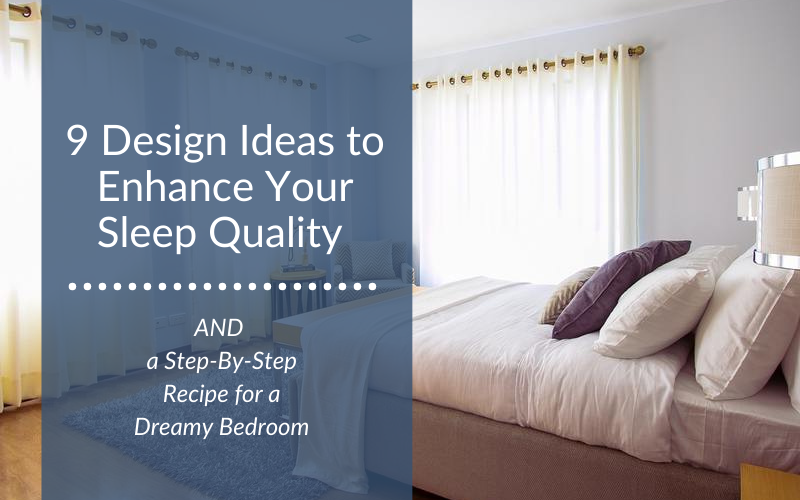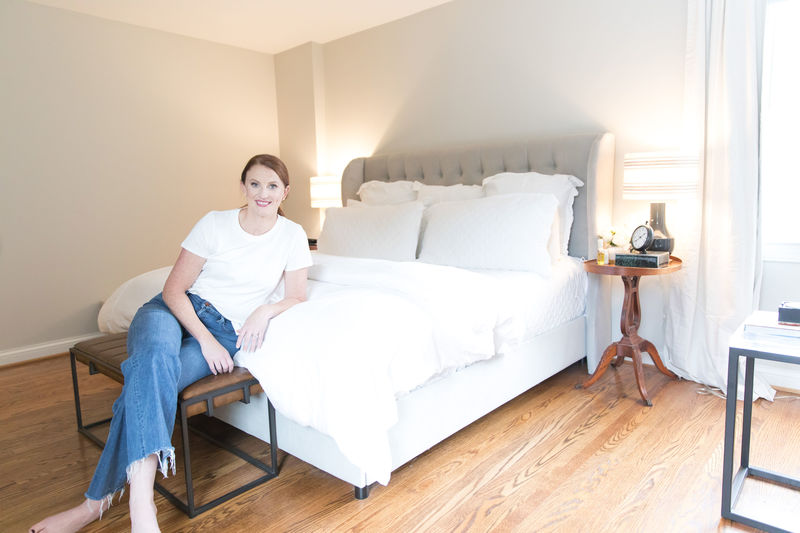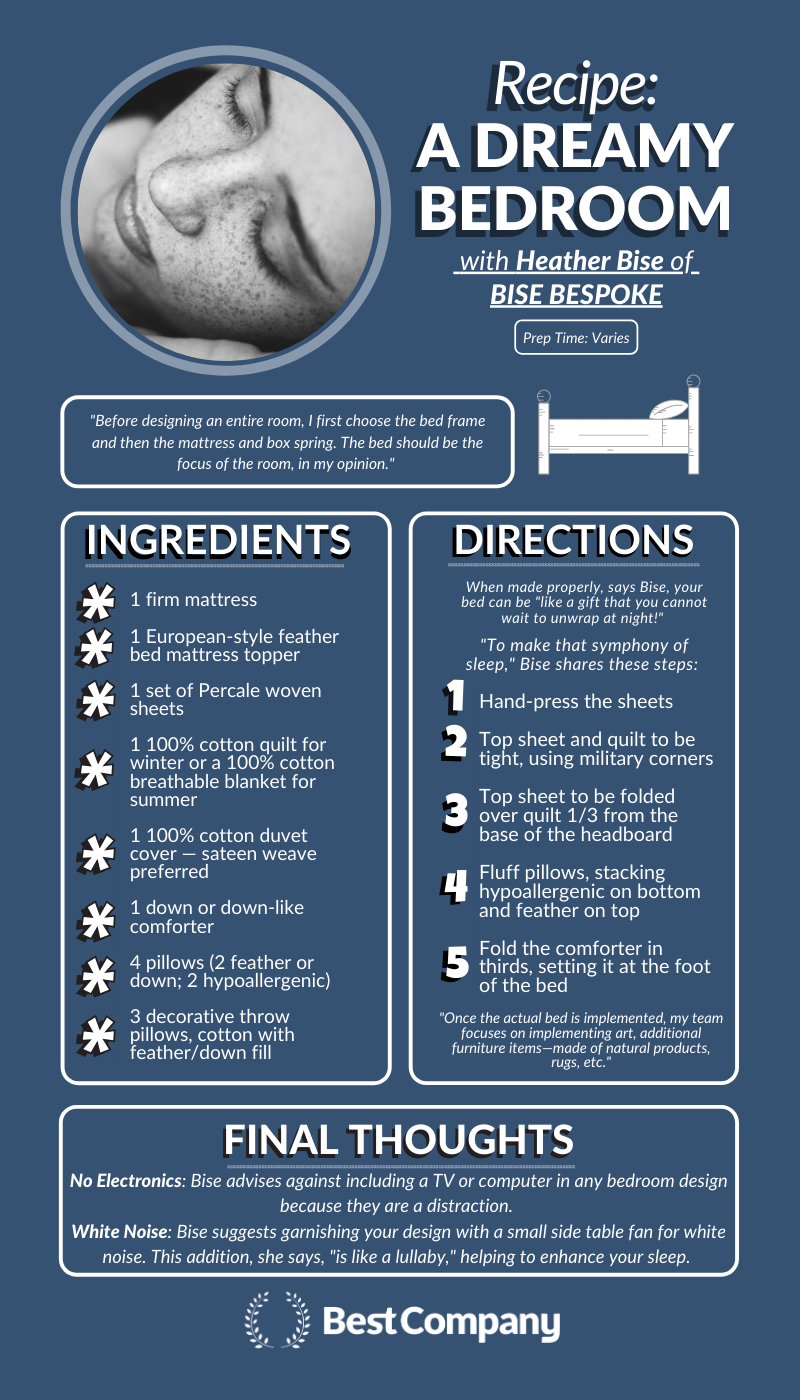9 Design Ideas to Enhance Your Sleep Quality + a Step-By-Step Recipe for a Dreamy Bedroom
Topics:
Improve Your Sleep
"Our lives are seemingly becoming busier and busier on a daily basis, and getting the rest your mind and body need on a nightly basis can prove to be difficult," says Bill Fish, a certified sleep science coach and cofounder of the sleep website Tuck. "While the National Sleep Foundation states that each adult needs between seven and nine hours of sleep per night, what is often overlooked is the quality of said sleep."
However, quality sleep is about more than just closing your eyes. "Many times," says Fish, "the biggest culprit for lack of quality sleep is your sleep environment, i.e., your bedroom. To give yourself the best chance to get a consistent quality night of sleep, it is recommended that you turn your bedroom into a sleep sanctuary of sorts. While this may sound daunting, some simple changes can make the world of difference."
You'll get better results when your environment is tailored to the task at hand. Here are nine expert design ideas to help improve your sleep environment and boost the quality of your sleep.
1. Add some greenery

Léon & George Chair Group with Plants via Léon & George
Studies have shown that just being around plants benefits your health and well-being in several ways. Texas A&M includes the following benefits of greenery in that list:
- Accelerated healing
- Improved memory and concentration
- Improved interpersonal relationships
- Increased feelings of compassion
- Reduced stress and improved moods
You don't have to go outdoors or hiking to benefit. Psychology Today says that the benefits to your health, comfort, and happiness are even improved by potted plants. Indoor plants offer purified air, reduced anxiety, and a host of benefits. Houseplants can be purchased at supermarkets, nurseries, and home improvement stores; however, they are also available to order online, from the comfort of your own home. For example, Léon & George offers living houseplants pre-potted in custom ceramic pots that design-lovers will appreciate, all delivered straight to your door. Purchases come with lifetime plant doc support and the company plants a tree for each plant sold.
2. Make it dark
"Both natural and artificial light can prevent or stop the release of the sleep-promoting hormone melatonin," adds MacDowell. "One of the best ways to make sure that you're getting not only the right amount of sleep but the best quality of sleep is to block out as much light as possible," advises Sharron Saunders from CB Carpets & Blinds. In fact, a National Sleep Foundation survey found that 73 percent of respondents considered a dark room to be an important factor necessary for a good night's sleep. There are several ways to block external light with window coverings.
"Creating a dark environment is one of the best ways to cue the body that it's time to relax and to sleep, says Katie Golde, Editor and Head of Sleep Research for Mattress Clarity. "Investing in blackout curtains will without a doubt maximize your sleep in your bedroom. These are similar to standard curtains but they're thicker and more opaque so they can block out as much light as possible." Fish adds, "Blackout curtains will block out any light pollution from cars going by, or if you are fortunate enough to be able to sleep past the rise of the sun, block the light of the sun from entering your room."
"To ensure that you're getting the best quality of sleep and blocking as much light as possible," Saunders suggests combining blinds and curtains. "Having both of these will mean that you're able to obstruct the light's path to you and keep it on the outside of your bedroom. Having perfect fit blinds or even a made-to-measure roller blind will help to keep the room as dark as possible. These are ideal because there are so many options available, especially after the 'black-out blind' design has had such a success. These are usually made of thicker material in order to keep the room as dark as it can get. With this, light can sometimes slip through the cracks slightly and so a curtain on top of the blind is an ideal way to keep things dark."
Light is also an important indicator for your body's sleep-wake cycle. With that in mind, Durkin shares this suggestion: "Dimming the lights about an hour before bed will tell your brain it’s time to shift into sleep mode." She recommends 60 to 70-watt bulbs for your lamps to help trigger your body's cycle.
Along the same lines, Nash suggests trying to remove the feeling of artificial light to help relax. She suggests using warm or natural-toned bulbs and downward-facing lamp shades. "By creating a warm and inviting bedroom environment," she says, you will inevitably sleep better."
Fresh take: You should take care to avoid melatonin-suppressing blue light, too. Durkin suggests, "Avoid distractions by removing all electronics from your room, including your digital alarm clock. If that's not possible, get one that emits amber light instead of blue light." The National Sleep Foundation even suggests a 30-minute reprieve from electronics before bedtime.
"It should also be noted that over 50 percent of adult Americans get up at least once per night to use the restroom," says Fish. "If your phone is by your nightstand, you are going to be subconsciously tempted to pick up your phone to check email, scroll through Twitter, and whatnot. This temptation could easily be avoided by charging your phone in another room."
3. Regulate the temperature
Temperature is an important factor when it comes to quality sleep. Dr. Christopher Winter, MD, writes in HuffPost that "most studies agree that a temperature between 60 and 67 degrees Fahrenheit is optimal for sleeping, with temperatures above 75 degrees and below 54 degrees disruptive to sleep. Body temperature has also been linked to the amount of deep sleep an individual gets during the night, with cooler body temperatures leading to more deep sleep."
Skin temperature, sweating, and rapid temperature changes can reduce sleep quality. "[M]any men and women suffer from sleep disturbances often caused by temperature regulation issues," explains environmental sleep specialist Anita Mahaffey, CEO, and Founder of San Diego-based Cool-jams, Inc. "Some of the most common reasons for temperature regulation problems include alcohol consumption, menopause, male and female hormonal fluctuations, diabetes, thyroid issues, obesity, certain meds, and a condition called hyperhidrosis," says Mahaffey. "All of these issues can lead to sleep temperature incompatibility in people of all ages."
So, what can we do?
Adjust the thermostat. Carefully consider your sleeping attire and bedding. Mahaffey's company, Cool-jams, aims "to help the sleeper achieve the optimum sleep temperature range." She adds, "Our sleepwear and bedding is a great way for folks who get overheated and sweaty to stay cooler and drier." The brand uses specially selected materials to help people sleep cool, offering bedding, pillows, and mattress pads, in addition to pajamas for men and women.
Even your mattress can be chosen to help with your individual sleep needs. "If you’re a hot sleeper, choose a mattress designed to keep you cool and bedding made of wicking fabrics," says Rose MacDowell, Chief Research Officer for Sleepopolis. On the other hand, she suggests, "Cold sleepers can choose warmer materials like memory foam, microfiber and flannel sheets, and faux fur throws that make going to bed an experience to look forward to."
4. Clean your room

Kim Jones' Clutter-Free Bedroom photo by Jama Finney Photography via Kim Jones L+K Home Organization
"Cluttered bedrooms are chaos for our minds," says Sherri Monte, who co-owns an interior design and professional home organizing firm in Seattle called Elegant Simplicity. "When there are things everywhere and there's an absence of organizing systems we are overstimulated, less efficient and become stressed because we can't find what we need. All these things make it difficult to envision your bedroom as the relaxing sanctuary it should be."
"To get the maximum about of sleep, it helps to not sleep surrounded by clutter," agrees Kim Jones from L+K Home Organization. "Even though your eyes are closed, it is the last thing you saw when going to sleep and your body is filled with anxiety. It is also the first thing you see when you wake up."
What should we focus on when decluttering?
The top of your nightstand, dresser, and other bedroom furniture are hotspots for clutter. Jones, the author of a recently released book, The No-Nonsense Home Organization Plan: 7 Weeks to Declutter in Any Space, suggests keeping these surfaces clear of piled-up mail, but that doesn't mean you need a plain, non-descript bedroom where everything is hidden in a drawer. Your bedroom should still be functional. For example, she suggests limiting your nightstand to "a book, your favorite picture, a lamp, and an alarm clock." All four have a purpose. She shares this outlook: "You want your bedroom to feel and look like a personal sanctuary or that you are staying at the nicest five-star hotel — where you don't have laundry piled in the corner that you know you need to get to, at some point."
It's more than just a cleaner room. Removing visual cues that bring you anxiety can help improve your sleep. Florida-based interior designer Pamela Durkin helps puts negative bedroom clutter into perspective. She shares this suggestion: "Get rid of clutter; a messy bedroom can affect your ability to relax. Remove guilt-inducing items like unfolded laundry and treadmills."
As Beth Nash from Alexander Joseph suggests, "Creating a clutter-free, no mess, no work, well-organized room will put your mind and body at ease allowing you to rest easier."
5. Re-think your mattress
Your mattress can be an important factor in maximizing your sleep. Monte shares: "As an interior designer, we're focused on the way the bed looks from headboards to bed linens but if getting the best night's sleep is important then so is the mattress you sleep on. Where else do you stay in one spot for six to nine hours at a time without moving? It better be comfortable."
A comfortable bed is key to ensuring good sleep, agrees Golde. "Not only sleeping on a mattress that provides neutral head, neck, and spinal alignment but in a bed that's the appropriate size. I would prioritize making space for a Queen or King-sized bed if you sleep with a partner. Snoring, movement, sheet stealing, and extra heat are all sleep disrupters that can be remedied with a little extra space."
6. Upgrade your bedding
"A poll carried out by the National Sleep Foundation (NSF) found that maintaining a clean bedding environment can lead to more restful sleep," says Karin Sun, founder of Crane & Canopy, a luxury bedding company. She adds, "Scratchy, thin, or poor quality bedding can be detrimental to great sleep. For the ultimate comfort and luxury, choose cotton sateen bedding, crafted from premium extra-long staple cotton, in a 300–400 thread count. Exceptional foundational elements like silky-soft sheets, chic and cozy duvet covers, and comfy pillows both look stylish and promise the sweetest dreams."
"Freshly washed linens can make sleeping much more pleasurable," adds Durkin. "Try spraying them with lavender or vanilla linen spray. The best sheets are 100 percent Egyptian cotton. Their long fibers produce lightweight yet durable sheets."
7. Keep it quiet
"Making sure that your room is quiet is key to a good sleeping pattern and deep sleep," says Aaron Cambden from Fairview Estates. "If you're a light sleeper, a quiet space to sleep is even more important because you'll be waking up every few minutes otherwise."
He has a point. Noise, or the lack thereof, is an important factor in creating the optimal sleeping environment. A 2018 scientific review even found that "all forms of noise" should stay below 35 db.
What can we do to help?
"[I]n the interest of keeping things quiet, sound dampening is an important part," says Cambden. "You can do this through a number of ways but the easiest way is to hang the right features and fixtures on the wall — whether that means that you need to be hanging a few pictures, putting up a set of curtains, or even creating an accent wall to add character and absorb the sound."
Another option is to help muffle exterior noise. Fish suggests, "A white noise machine will help muffle the sounds that could tend to wake you overnight. Whether it is your neighbor’s dog barking at a squirrel at midnight or a delivery truck lumbering up your street at 6 a.m., a white noise machine can mask those sounds and allow you to stay in a deep sleep to get the rest you need to attack the next day."
Switching up your bedroom layout and design can also help. "If you have noisy neighbors or sleep next to a loud utility room, minimize the disruption by pulling your bed away from the wall," advises MacDowell . She also suggests using thick carpet or area rugs to help reduce noise, "Carpet can not only decrease noise from downstairs neighbors, but it can also create a cozy, soothing environment that helps you fall asleep faster." Win. Win.
8. Update your color scheme
Quiet and muted colors are a good design scheme for a bedroom, says Durkin, "These produce a reduced heart rate, lower blood pressure, slower respiration, and constricted pupils — all conditions that signal it's time to rest."
What color are your walls? This is important. "Not to be all boring but vibrant colors are best in bedrooms for textiles and decorative accents," advises Monte. "Painting your walls with bold colors could make it difficult to get a sound night's sleep. That's not to say you can't bring color into your bedroom. Instead, use soothing colors in the soft or muted colorways."
What about your bedding? Sun suggests neutral and calming colors. "Color choices in your bedroom can largely affect how calm you feel and how well you sleep. While bold colors, particularly warm-toned reds and bright pinks, can look lovely and stylish, they can also evoke feelings of unrest or agitation. For the most serene sleep, adorn your bedroom in shades of soft greens, breezy blues, and temperate greys."
Another tactic, is decorating with your emotional center color, says B.P. Greycastle, author of Your Name and Colors Key to Your Beauty, Career, Personality, Romance, and, Success. Decorating with your emotional center color helps by "releasing hormones that allow for the reduction of stress and allow for better sleep," says the author. His book explains, "how our color-coded names determine our personality character traits and talents of our seven energy centers. Eastern philosophies refer to these centers as the seven chakra centers, and I refer to them as our seven energy/personality centers. If you look at an endocrine gland chart, those seven centers are in the same exact place so what the eastern philosophies are really talking about is our seven endocrine gland centers."
9. Create a sitting area
"One of the rules of good sleep hygiene is to reserve the bed for sleep and sex only," says MacDowell. "Why? To avoid associating the bed with waking activities such as reading, working, or watching TV. Instead, create a relaxing sitting area in your bedroom for pre-bed activities and go to bed only when you’re ready to sleep."
Dreamy bedroom recipe
Heather Bise is the founder of Bise Bespoke. She works as a design curator for short-term rental properties and even teaches a three-day AIRBNB Bootcamp for people wondering if they have what it takes to be an Airbnb Superhost. Bise shares with us her recipe for a dreamy bedroom:
The Top Mattresses Companies



The Top Mattresses Companies



Related Articles
By Guest
March 28th, 2020
February 24th, 2020
Mattresses
20 Sleep Hacks for Holiday Travel
April 8th, 2021
Get Our Newsletter - Be in the Know
Sign up below to receive a monthly newsletter containing relevant news, resources and expert tips on Mattresses and other products and services.
We promise not to spam you. Unsubscribe at any time. Privacy Policy
